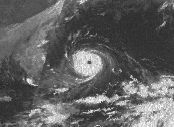Typhoon Cora (1966)
This article needs additional citations for verification. (August 2020) |
| Category 5 super typhoon (SSHWS) | |
 | |
| Formed | August 28, 1966 |
|---|---|
| Dissipated | September 7, 1966 |
| Highest winds | 1-minute sustained: 280 km/h (175 mph) |
| Lowest pressure | 918 hPa (mbar); 27.11 inHg |
| Part of the 1966 Pacific typhoon season | |
Typhoon Cora, as known as the 2nd Miyakojima Typhoon (第2宮古島台風) in Japan,[1][2] was a typhoon struck the Ryūkyū Islands in 1966.
Meteorological history

Typhoon Cora, which began its life on August 30, attained peak winds of 175 mph on September 5. It passed near Okinawa, causing major damage to the infrastructure on the island, but no loss of life. Cora continued to the northwest, hit northeastern China as a super typhoon on the 7th, and turned northeast to become extratropical near South Korea on the 9th.
Impact
Slowly moving by the southern Ryukyu Islands,[1] Cora battered the region for more than 30 hours. Miyako-jima suffered the brunt of the typhoon's impact; sustained winds on the island reached 219 km/h (136 mph) while gusts peaked at 307 km/h (191 mph). This placed Cora as a greater than 1-in-100 year event in the region. Winds of least 144 km/h (89 mph) battered Miyako-jima for 13 continuous hours. Of the 11,060 homes on Miyako-jima, 1,943 were destroyed and a further 3,249 severely damaged. The majority of these were wooden structures whose structures were compromised once their roof was torn off. Steel structures also sustained considerable damage while reinforced concrete buildings fared the best. The resulting effects rendered 6,000 residents homeless. The scale of damage varied across the island with Ueno-mura suffering the most extensive losses. Of the community's 821 homes, 90.1 percent was severely damaged or destroyed. A United States Air Force radar station was destroyed on the island. On nearby Ishigaki Island, where wind gusts reached 162 km/h (101 mph), 71 homes were destroyed while a further 139 were severely damaged. Total losses from Cora in the region reached $30 million. Despite the severity of damage, no fatalities took place and only five injuries were reported.

Wind gusts up to 130 km/h (80 mph) caused notable damage in Taiwan, with 17 homes destroyed and 42 more damaged. A smaller island closer to the storm reported a peak gust of 226 km/h (140 mph). Heavy rains were generally confined to northern areas of the island, peaking at 405 mm (15.9 in). Three people were killed during Cora's passage while seventeen others sustained injury. Additionally, 5,000 persons were evacuated. Damage amounted to NT$4.2 million. Striking Fujian Province, China, on the heels of Typhoon Alice, Cora exacerbated damage in the region. Property damage was extreme with more than 21,000 homes destroyed and nearly 63,000 more damage. An estimated 265,000 people were severely affected by the storm. A total of 269 people perished during the storm while a further 2,918 were injured; 52 people were also listed missing. Tremendous flooding occurred as a result of the rains from Alice and Cora, damaging 190,000 hectares (469,000 acres) of crops which resulted in a loss of 195,000 kg (430,000 lb) in food production.
The JMA in Japan named the typhoon 2nd Miyakojima Typhoon.[1][2]
| Name | Number | Japanese name |
|---|---|---|
| Ida | T4518 | Makurazaki Typhoon (枕崎台風)[4][5] |
| Louise | T4523 | Akune Typhoon (阿久根台風) |
| Marie | T5415 | Tōya Maru Typhoon (洞爺丸台風) |
| Ida | T5822 | Kanogawa Typhoon (狩野川台風) |
| Sarah | T5914 | Miyakojima Typhoon (宮古島台風) |
| Vera | T5915 | Isewan Typhoon (伊勢湾台風) |
| Nancy | T6118 | 2nd Muroto Typhoon (第2室戸台風) |
| Cora | T6618 | 2nd Miyakojima Typhoon (第2宮古島台風) |
| Della | T6816 | 3rd Miyakojima Typhoon (第3宮古島台風) |
| Babe | T7709 | Okinoerabu Typhoon (沖永良部台風) |
| Faxai | T1915 | Reiwa 1 Bōsō Peninsula Typhoon (令和元年房総半島台風) |
| Hagibis | T1919 | Reiwa 1 East Japan Typhoon (令和元年東日本台風) |
See also
- Typhoon Sarah (1959) - the JMA named it Miyakojima Typhoon
- Typhoon Della (1968) - the JMA named it 3rd Miyakojima Typhoon
References
- ^ a b c "第2宮古島台風 昭和41年(1966年) 9月4日~9月6日". www.data.jma.go.jp (in Japanese). Retrieved 2020-08-08.
{{cite web}}: CS1 maint: url-status (link) - ^ a b "第2宮古島台風(1966年9月5日) | 災害カレンダー". Yahoo!天気・災害 (in Japanese). Retrieved 2020-08-08.
- ^ "気象庁が名称を定めた気象・地震・火山現象一覧" (in Japanese). Japan Meteorological Agency. Retrieved 20 February 2020.
- ^ "枕崎台風 昭和20年(1945年) 9月17日~9月18日". www.data.jma.go.jp (in Japanese). Retrieved 2020-08-08.
- ^ 第三版,日本大百科全書(ニッポニカ), ブリタニカ国際大百科事典 小項目事典,朝日新聞掲載「キーワード」,デジタル大辞泉,百科事典マイペディア,世界大百科事典 第2版,大辞林. "枕崎台風(まくらざきたいふう)とは". コトバンク (in Japanese). Retrieved 2020-08-08.
{{cite web}}: CS1 maint: multiple names: authors list (link) CS1 maint: numeric names: authors list (link)

